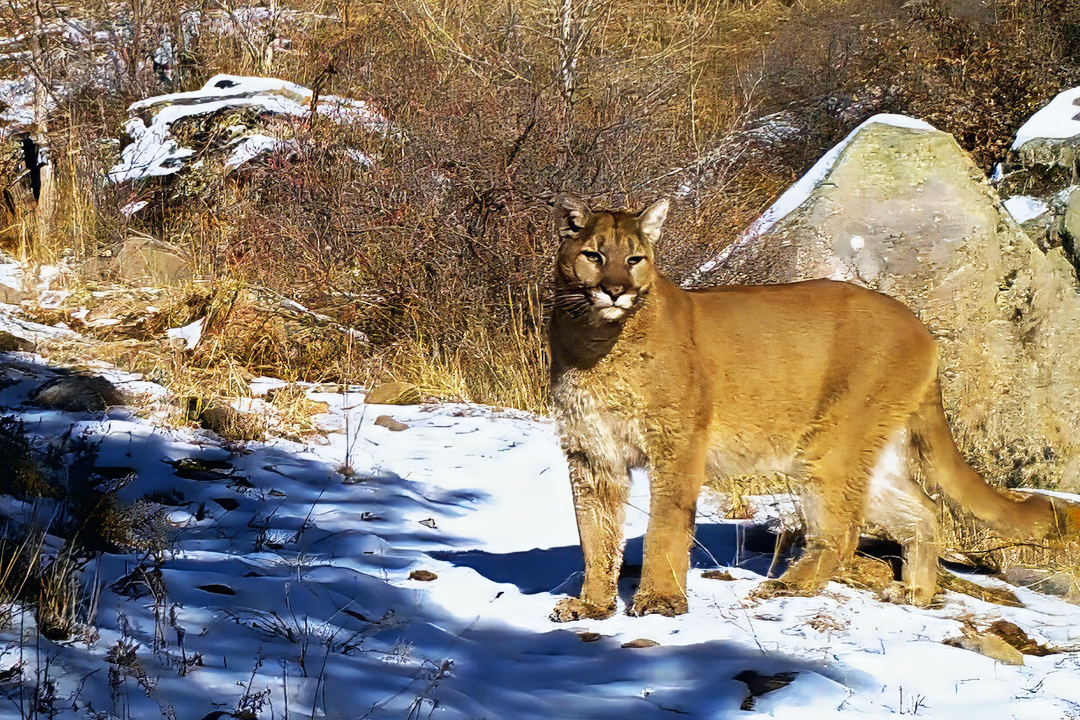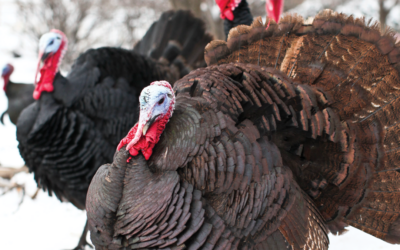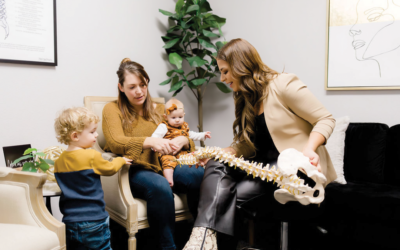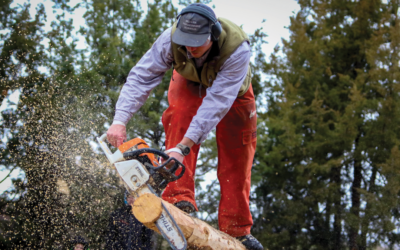As he hikes through the woods, there are times when David Neils knows he’s being watched.
He may not see mountain lions gazing down on him. But later, his cameras show them spying on him.
Neils has a healthy respect for mountain lions. He calls them “apex” predators, scientists’ way of saying they’re the top dogs, even if they’re cats. They rank among wolves and grizzly bears, he says, but he doesn’t fear them. In fact, he will likely spend the rest of his life fighting for them.
His closest encounter with a mountain lion was his first, and it’s what inspired him, in 2001, to start Wild Nature Media, a business that emphasizes conservation, research and education about what he calls the “raw, unfiltered beauty of the natural world.”
Neils detests nature shows that seek to entertain rather than educate. Several, he says, capture mountain lions and fatten them on feedlot meat, then lead them out on leashes to mountain ridges for Hollywood productions that meet the public’s expectations of what they’re like. Those shots are usually coupled with cheesy narrations Neils compares to a car salesman’s pitch.
“It’s just awful,” he says, “and the important thing is, wildlife deserves better than that.”
He calls his footage “the real deal” as it depicts mountain lions’ wild behavior in their own habitat. He tries not to influence their behavior except by installing the camouflaged cameras triggered by movement. Sometimes that’s enough: He has footage of four separate instances when a mountain lion sniffed a camera out of curiosity two minutes after he left.
Since mountain lions are at the top of the food chain, Neils says the West holds a bias against them. Technically, they do pose a threat, even if he says the chances of getting attacked are one in several million (stats back him up), but they also serve an important role: Mountain lions keep wild places wild.
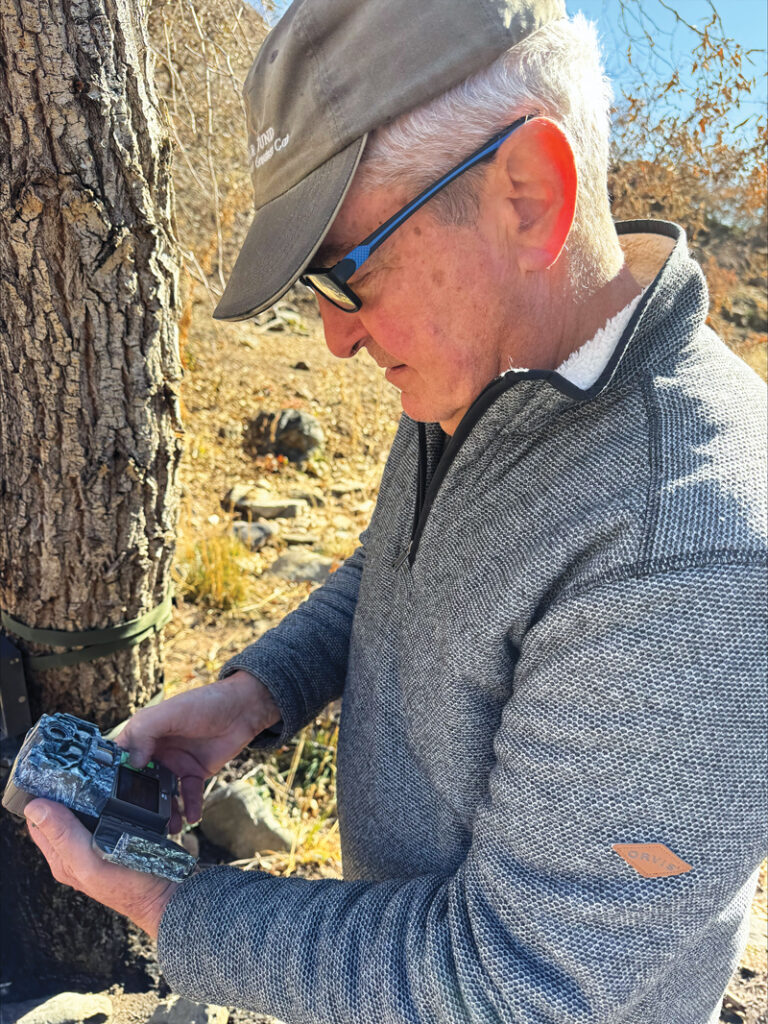
David Neils checking one of his trail cams.
Photo by Dan England.
Into the wild
Neils has spent more than 30,000 hours in the field studying mountain lions. He began learning about wildlife when he was 6 years old growing up in a thick forest that surrounded his parents’ home in Libby, Mont. He was surrounded by apex predators, including grizzles seemingly big enough to swallow him in a gulp, but by the time he was 11, his parents let him spend a week or more camping on his own without so much as a radio. He’d mark his route on a map, hand it to his parents and tell them if he wasn’t back in the three-day window he marked on their calendar they’d probably better start looking for him. He’s aware that if they allowed that today, social workers might sweep him away into foster care, but he calls their trust one of the greatest gifts he ever received.
Neils, now 64, prefers to remain in the background, just like the 45 cameras he has sprinkled throughout Sylvan Dale Guest Ranch and four other places across Northern Colorado. What keeps him out in those woods, checking his cameras every few days, is the belief that there’s always more to learn and share with the world.
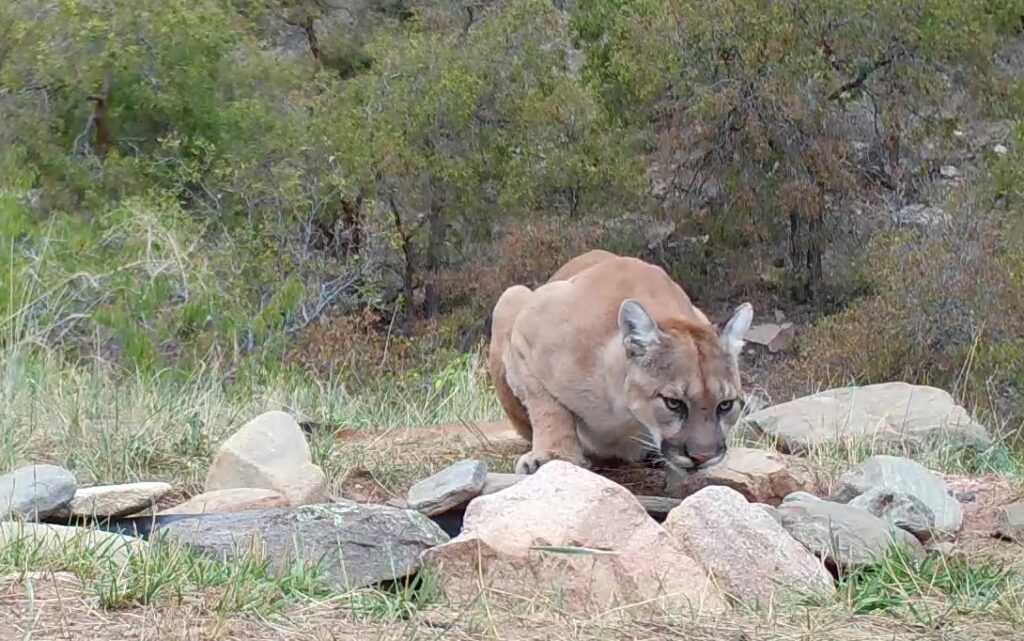
Photo by Wild Nature Media
A chance encounter
Decades ago, Neils settled down for an afternoon snooze at 11,000 feet while bowhunting, his head on his arm so he wouldn’t snore himself awake, when he felt a push on his cheek, like someone had brushed him with a wet towel. He startled awake, saw a flash of fur and knew enough to recognize the paw tracks, with their claws extended, in the wet mud. He’d been bumped on the face by a mountain lion.
“I thought, ‘Wow, why didn’t you eat me?’” he says. “The first thought I had was that I hadn’t showered in two days, and maybe his mom told him you should never eat a carcass that has started to turn.”
Neils recalls his bow feeling much smaller then, more like a walking stick, but that didn’t matter. He never saw the mountain lion again. And yet, in minutes, his fear turned to fascination.
“I thought, right then, ‘I’m going to devote a big chunk of my life to learning anything I can about this animal,’” he says.
Neils never worked as a professional biologist, though his passion for wildlife persisted through his careers in forestry, tech and youth mentorship. He started capturing wildlife photos by buying Sony point-and-shoots off eBay, taking them apart, rewiring them and matching their cases to the barks of the trees where he posted them. Once he figured out how to rig video cameras, he never went back.
The goal isn’t to make money, he says. He does sell his footage, but it’s to media outlets such as National Geographic, PBS and Animal Planet, all of which emphasize conservation. He also consults with others who want to do what he’s doing in their areas or countries (he has a client in Israel). The main goal, he says, is to inform the public. His photos have had views from all 195 countries around the world.
“The public deserves accurate information about wildlife as a basis for wildlife conservation efforts,” he says.
A symbiotic relationship
Neils spends much of his time at Sylvan Dale Guest Ranch, which is, ironically, one of the wilder places in Northern Colorado as nearly 80 percent of its 3,200 acres is under a conservation easement that prevents it from being developed. There are some cattle, but other than occasionally knocking down one of his cameras, they don’t cause many problems.
He called the ranch owners, Susan Jessup and Dave Armstrong, 18 years ago and asked them if he could install some cameras on their property. In return, he would provide them with any footage they wanted and take their guests on nature hikes. They continue their relationship to this day, and it’s one of Neils’ favorite places to work.
The hours he’s spent at the ranch have given him an opportunity he treasures: A chance to get to know a wild area. He knows of a little water hole that’s so perfect he’s set up two cameras to capture all the wildlife that visit, including a mama bear with two cubs that was so entranced by the pool she lay on her back in the middle of it and soaked in the sun.
He knows when the grasshoppers come in the spring and when wild turkeys, ravenous for protein, gather for a week or so to gobble them, and how predators know it’s the only chance to grab the smart birds while they’re distracted by the feast. He knows how the wind funnels into a concentrated spot with enough shelter and shade that mountain lions will sit there and take in all the scents so they know where to strike.
His intimate knowledge of the land and the tens of thousands of hours he’s spent on it help him nab footage of mountain lions. It’s rare for anyone to get photos or videos of mountain lions, but he finds footage on his cameras quite often.
Larimer County is more than 50 percent public land, he says, so numerous opportunities exist for others to learn about a piece of land the way he has. Some areas, such as Soapstone Prairie Natural Area and Red Mountain Open Space, tend to be devoid of people, especially on weekdays.
“There’s a lot of wild country that we have in the county,” Neils says. “If you want to have a richer experience when you’re out in nature, go there at different times of the day and different times of the year. Get to know a few places really well.”
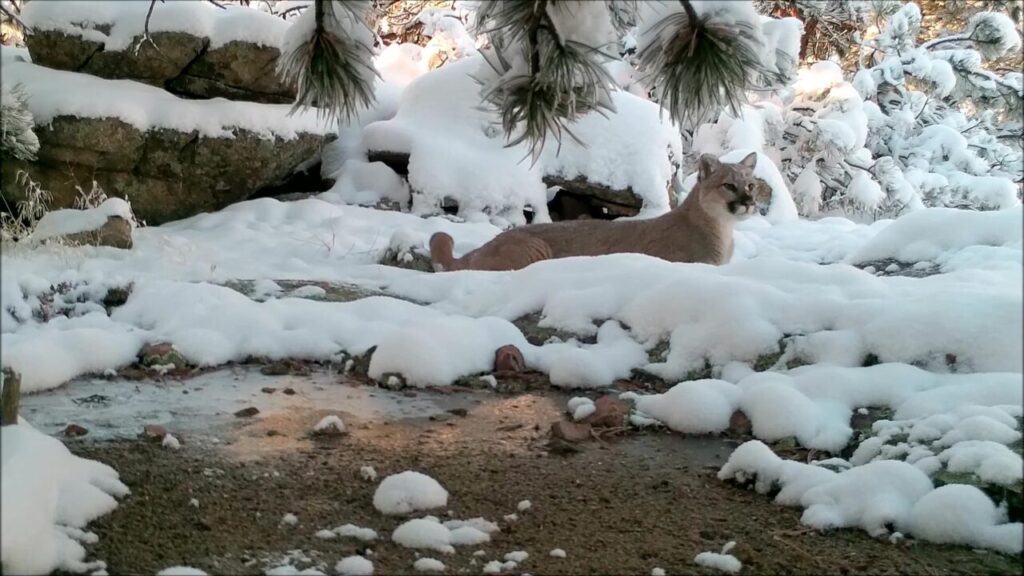
Photo by Wild Nature Media
Keeping nature wild
Getting to know the land helps people appreciate the importance of mountain lions, Neils says. After all, the land wouldn’t be the same without them.
Other animals’ wariness of mountain lions means they can’t stay in an area too long and overgraze it, he says. If the prey don’t stay wild, meaning they lose their ability to run fast and stay fit, that’s when mountain lions will pounce.
“They keep the prey on the move,” Neils says. “These aren’t the elk you’ll see on a golf course in Estes Park chewing on Kentucky bluegrass.”
Mountain lions also provide food for many other scavengers that pick off the leftovers of carcasses, he says.
It’s hard to say just how many mountain lions are in Larimer County, but the state estimates there are as many as 4,500 in Colorado. That’s why Neils voted for Colorado Proposition 127 last year, which would have banned mountain lion hunting. Neils has hunted before, but he says mountain lions’ scarcity compared to elk or deer means they don’t need the same population controls that hunting provides.
However, Mark Vieira, carnivore and furbearer programs manager for Colorado Parks and Wildlife, says the state’s mountain lion population is “robust” and can support the 2,500 licenses the state sells every year. Mountain lions are hard to find and even harder to kill, so most of those tags won’t be filled. Plus, nearly half of the best mountain lion habitat in the state is on natural areas or other land where hunting is forbidden, he says.
The state will continue to monitor mountain lion populations and adjust the number of licenses it sells as a result. Vieira says it’s important to have a strong and stable mountain lion population to keep all the benefits Neils mentions intact.
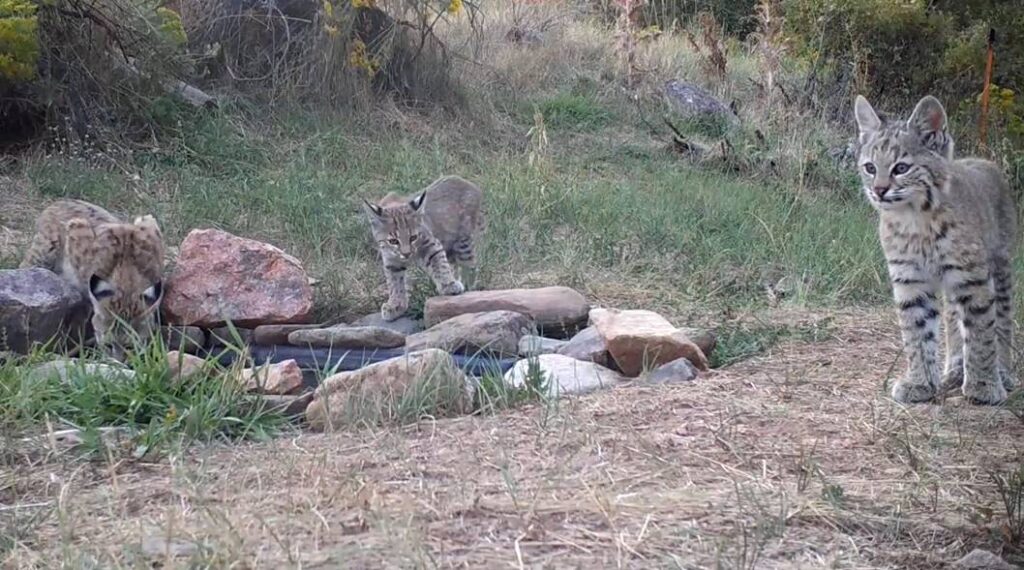
Bobcat family. Photo by Wild Nature Media.
Demystifying the predator
Neils’ work plays an important role in helping the public understand mountain lions, Vieira says. For instance, the public is generally nervous when there’s a mountain lion sighted near their home, though they don’t seem to panic when they are, say, camping in the mountains and one was reported nearby.
“It demystifies this creature,” Vieira says. “We have an unease with the unknown. I’m always an advocate for the public understanding and knowing more, and that can include charismatic predators like mountain lions. That can happen anytime the public can see a mountain lion in its natural habitat.”
Neils is unsure how much of a difference his footage makes, but he thinks it has a positive impact based on the interest he’s garnered across the world. While he can’t see people looking at his films of mountain lions, he can meet them on his tours at the ranch.
He recalls a recent trip with a little girl who wore pink shoes with princesses on them and cried when they reached their destination. He thought he’d done something to frighten her and was surprised to hear her answer when he asked why she came that day.
“I want to learn about bears, and I want to help bears,” she answered. She was crying because the trip was over.
It was a pivotal moment for Neils, just like the one he had decades ago with the mountain lion that bumped him on the face. He smiles at both memories, and as he leaves the ranch, he closes the gate behind him in case he’s being watched.
To learn more and view recent sightings visit wildnaturevideo.com, and find @WildNatureMedia on YouTube.


